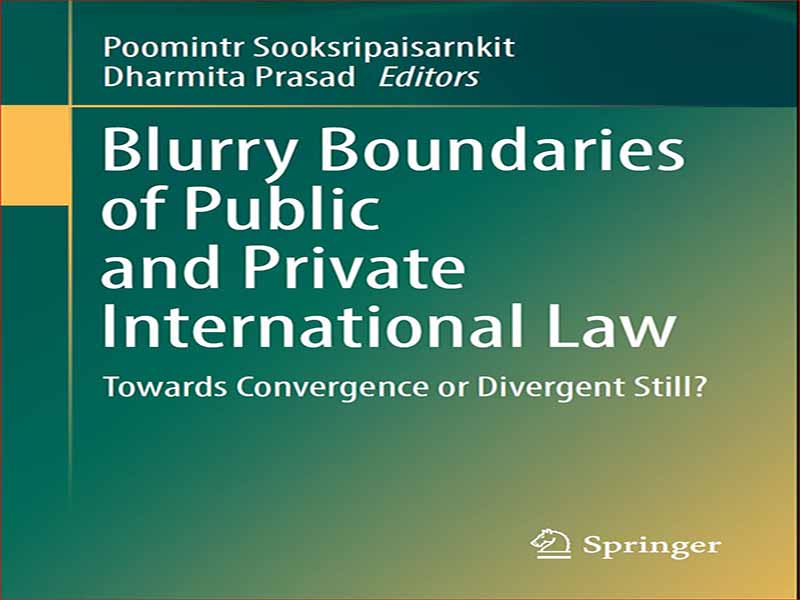- عنوان کتاب: Blurry Boundaries of Public and Private International Law
- نویسنده: Poomintr Sooksripaisarnkit
- حوزه: حقوق بین الملل
- سال انتشار: 2022
- تعداد صفحه: 287
- زبان اصلی: انگلیسی
- نوع فایل: pdf
- حجم فایل: 3.45 مگابایت
حقوق بین الملل عمومی و حقوق بین الملل خصوصی (یا تعارض قوانین) در اکثر دانشکده های حقوق به عنوان موضوعات جداگانه تدریس می شوند. به ما گفته شد حقوق بین الملل عمومی به رفتار و روابط بین دولت ها یا بین دولت ها و سازمان های بین المللی می پردازد. از سوی دیگر، حقوق بین الملل خصوصی به روابط حقوقی خصوصی بین اتباع یا شرکت ها در دو کشور مختلف می پردازد، از جمله قراردادهای بین المللی، ازدواج های بین کشوری، جرایم بین المللی و غیره. در واقع این چیزی نیست جز شاخه ای از حقوق داخلی که به پرونده های مربوط به عناصر خارجی می پردازد. به عنوان بخشی از حقوق ملی، منابع حقوق بین الملل خصوصی را می توان بسته به نظام حقوقی در منابع داخلی، چه در اساسنامه و چه در قوانین قضایی و یا ترکیبی از هر دو، یافت. از سوی دیگر، منابع حقوق بینالملل عمومی، مواردی است که در ماده 38 اساسنامه دیوان بینالمللی دادگستری آمده است، یعنی کنوانسیونهای بینالمللی، حقوق عرفی بینالمللی، اصول کلی حقوقی که توسط کشورهای متمدن به رسمیت شناخته شده است، تصمیمات قضایی و آموزههای تبلیغاتیهای مجرب. . اختلافات بین شهروندان یا شرکت های کشورهای مختلف در یک سیستم دادگاه معمولی حل و فصل می شود، یا از طریق یک توافقنامه صلاحیت قضایی یا در غیر این صورت، یا با سایر مکانیسم های حل اختلاف جایگزین، مانند داوری. از سوی دیگر، اختلافات بین کشورها از راه های سیاسی و سایر کانال های دیپلماتیک حل و فصل خواهد شد، اگر نه از طریق دیوان بین المللی دادگستری (ICJ). با این حال، ردی از تاریخ و تکامل حقوق بینالملل عمومی و حقوق بینالملل خصوصی به ما نشان داد که آنها در واقع از منابع یکسانی سرچشمه گرفتهاند. شیوههای معاصر به ما نشان داد که هرگونه تمایز واضح بین آنها غیر واقعی میشود. یک مثال خوب در حوزه فروش بین المللی کالا است که به طور سنتی در محدوده حقوق بین الملل خصوصی قرار می گیرد. افزایش پیوسته تعداد کشورهای عضو کنوانسیون سازمان ملل متحد در مورد قراردادهای فروش بین المللی کالا (وین، n1980) (“CISG”) نشانه آن است که کشورهای بیشتری از مواد حقوقی بین المللی عمومی، یعنی معاهدات استفاده می کنند. برای هماهنگ کردن و حل مسائل حقوق بین الملل خصوصی. در واقع، بخش عمدهای از کار سازمانهای بینالمللی مانند کمیسیون حقوق تجارت بینالملل سازمان ملل (UNCITRAL) یا کنفرانس لاهه در مورد حقوق بینالملل خصوصی (HCCH) در مورد حل مسائل بینالمللی خصوصی از طریق کنوانسیونهای بینالمللی است. از سوی دیگر، در حوزه حقوق بینالملل سرمایهگذاری که به طور سنتی در فضای حقوق بینالملل عمومی قرار میگیرد، توسل فزاینده طرفین به داوری سرمایهگذاری از آن زمان تاکنون این حوزه حقوق را در تعامل نزدیکتر با حقوق بینالملل خصوصی قرار داده است. در زمان کار روی این کتاب، همهگیری جهانی، یعنی کووید-19، هنوز چالشهایی را برای جامعه بینالمللی و همه ما به همراه دارد. محدودیتها و اقدامات پیشگیرانه متفاوت اتخاذ شده در کشورهای مختلف، دیدگاهها و مسائل جدیدی را هم در حقوق بینالملل عمومی و هم حقوق بینالملل خصوصی به ارمغان میآورد. هدف کلی این کتاب، همانطور که عنوانش نشان می دهد، کمک به بحث های جاری است که آیا ادغام یا همگرایی کافی بین حقوق بین الملل عمومی و حقوق بین الملل خصوصی وجود دارد، به طوری که تلقی آنها به عنوان موضوعات یا رشته های جداگانه غیرقابل توجیه شود. این کتاب در چهار موضوع به چنین بحث هایی می افزاید. موضوع اول به بررسی ملاحظات تاریخی و نظری مرز بین حقوق بین الملل عمومی و حقوق بین الملل خصوصی می پردازد. موضوع دوم به روند فزاینده هماهنگ سازی حقوق بین الملل خصوصی توسط اسناد حقوق بین الملل عمومی نزدیک تر است و شامل ارزیابی فرآیندها، مشکلات و اثربخشی است. در موضوع سوم، برخی از مطالعات موردی و تحلیل تقاطع بین حقوق بین الملل عمومی و حقوق بین الملل خصوصی ارائه شده است. در نهایت، موضوع آخر بر روندهای آینده در رابطه بین حقوق بین الملل عمومی و حقوق بین الملل خصوصی تمرکز دارد. در کار بر روی این کتاب، ویراستاران مفتخرند که این پروژه مکانی را برای محققان نوظهور در هر دو زمینه حقوق بینالملل عمومی و حقوق بینالملل خصوصی فراهم میکند تا تحقیقات خود را به نمایش بگذارند، علاوه بر فصلهایی که توسط محققان برجستهتر ارائه شده است. ویراستاران همچنین به بازنمایی های جغرافیایی در این کتاب با نویسندگان مستقر در آمریکای شمالی، آسیا، استرالیا، اروپا و غیره افتخار می کنند که به این کتاب طعم واقعی بین المللی می بخشد. برای این منظور، ویراستاران مایلند از Springer Nature Pte Ltd.، به ویژه Nupoor Singh که در طول روند تولید این کتاب حمایت کرده است، تشکر کنند. ویراستاران همچنین از دوست ما و همچنین یکی از همکاران این کتاب، دکتر سای رامانی گاریملا، که ما را به هم پیوند داد، تشکر می کنند.
Public International Law and Private International Law (or Conflict of Laws) are taught in most law schools as separate subjects. Public International Law, we were told, deals with the conduct and the relation between States or between States and international organisations. On the other hand, Private International Law deals with private legal relations between citizens or corporations in two different countries, being international contracts, inter-country marriages, international torts, etc. We were told the term “Private International Law” is a misnomer as in reality it is nothing more than a branch of domestic law dealing with cases involving foreign elements. As part of national law, sources of private international law can be found in domestic sources depending on the legal system, either in statutes or in case laws or in combination of both. On the other hand, sources of public international law are those listed in Article 38 of the Statute of International Court of Justice, namely international conventions, international customary law, general principles of law recognised by civilised nations, judicial decisions and teachings of highly qualified publicists. Disputes between citizens or corporations of different countries are settled in a typical court system, either by a jurisdiction agreement or otherwise, or by other alternative dispute resolution mechanisms, such as arbitration. On the other hand, disputes between States will be resolved through political means and other diplomatic channels, if not through the International Court of Justice (ICJ). Even so, a trace of history and evolution of public international law and private international law revealed to us that they indeed originated from the same sources. Contemporary practices revealed to us that any clear distinction between them becomes unreal. A good example is in the realm of the international sale of goods which traditionally falls within the ambit of private international law. A steady increase in the number of Member States to the United Nations Convention on Contracts for the International Sale of Goods (Vienna, n1980) (“CISG”) is a sign that more countries are adopting the use of public international lawmaterials, namely treaties, to harmonise and solve private international law issues. Indeed, the major parts of the work of international organisations such as the United Nations Commission on International Trade Law (UNCITRAL) or the Hague Conference on Private International Law(HCCH)are about solving private international lawissues via international conventions. On the other hand, in the realm of international investment law which traditionally falls within the public international law space, increasing resort to investment arbitrations by the parties has since brought this field of law in closer interaction with private international law. At the time of working on this book, the global pandemic, namely the COVID-19, still bring challenges to international community and to us all. Different restrictions and preventive measures adopted in different countries bring fresh perspectives and issues on both public international law and private international law. The overall aim of this book, as its title indicates, is to contribute to on-going debates whether there is a sufficient merge or convergence of public international law and private international lawsuch that treating them as separate subjects or disciplines becomes unjustifiable. This book adds to such debates in four themes. The first theme examines historical and theoretical considerations of the boundary between public international law and private international law. The second theme looks closer at the rising trend of harmonisation of private international law by public international law instruments and consists of evaluation of processes, problems and effectiveness. In the third theme, some case studies and analysis of intersectionality between public international law and private international law are presented. Finally, the last theme focuses on the future trends in relationship between public international law and private international law. In working on this book, the editors are proud that this project provides a venue for emerging scholars in both public international law and private international law fields to showcase their research, in addition to chapters contributed to by more established researchers. The editors are also proud of geographical representations in this book with authors based in North America, Asia, Australasia, Europe, etc., which give this book true international flavour. To this end, the editors would like to thank Springer Nature Pte Ltd., especially Nupoor Singh, who has been supportive throughout the process of production of this book. The editors would also like to thank our friend and also one of the contributors in this book, Dr. Sai Ramani Garimella, who connected us together.
این کتاب را میتوانید از لینک زیر بصورت رایگان دانلود کنید:
Download: Blurry Boundaries of Public and Private International Law




































نظرات کاربران